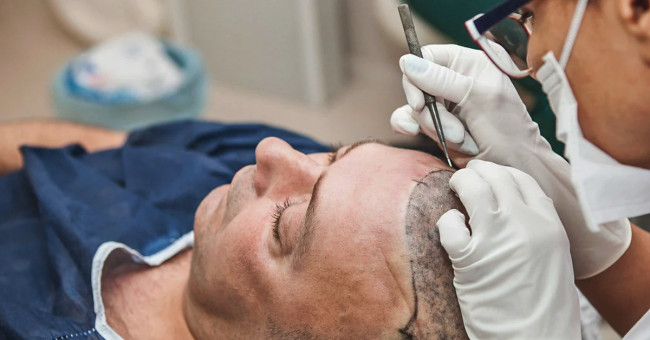
Hair loss can be a frustrating and embarrassing issue that affects both men and women. Fortunately, there are now more options than ever before for treating hair loss, and one of the most effective solutions is hair transplantation. If you're considering a hair transplant, it's important to understand the procedure and determine if it's the right choice for you. In this article, we'll explore the basics of hair transplantation and help you decide if it's the right solution for your hair loss.
What is a Hair Transplant?
A hair transplant is a surgical procedure that involves moving hair follicles from one part of the scalp to another. The procedure is typically performed under local anesthesia, and the surgeon uses a small, needle-like instrument to remove individual hair follicles from a donor site on the scalp. These follicles are then transplanted into the areas of the scalp where hair is thinning or balding.
There are two main types of hair transplants: follicular unit transplantation (FUT) and follicular unit extraction (FUE). FUT involves removing a strip of skin from the donor site, while FUE involves removing individual hair follicles. Both methods have their advantages and disadvantages, and your surgeon can help you determine which one is best for you.
Is a Hair Transplant Right for You?
If you're experiencing hair loss and considering a hair transplant, there are several factors to consider. First and foremost, you should have a clear understanding of your hair loss pattern and the potential results of the procedure. While a hair transplant can be an effective solution for many people, it may not be suitable for everyone. Your surgeon can help you understand the potential results and determine if a hair transplant is right for you.
It's also important to have realistic expectations about the procedure. A hair transplant can restore a natural-looking hairline and add density to thinning areas, but it's not a cure for baldness. If you have significant hair loss, you may need multiple procedures to achieve the desired results. Additionally, you'll need to be patient, as it can take several months to see the full results of the procedure.
Another factor to consider is the cost of the procedure. Hair transplantation can be expensive, and it's not usually covered by insurance. However, the cost can vary widely depending on the extent of your hair loss and the type of procedure you choose. Your surgeon can provide a detailed cost estimate and help you understand your financing options.
Finally, it's important to choose a qualified and experienced surgeon. Hair transplantation is a complex procedure, and the results depend largely on the skill of the surgeon. Be sure to choose a surgeon who has a proven track record of successful hair transplants and who is board-certified in plastic surgery or dermatology.
Kinds of Hair Transplants
There are two main types of hair transplants: Follicular Unit Transplantation (FUT) and Follicular Unit Extraction (FUE).
Follicular Unit Transplantation (FUT) involves removing a strip of skin from the donor area, usually the back of the head, which is then divided into individual follicular units. These units are carefully transplanted into the areas where hair is thinning or balding. This method typically leaves a linear scar at the donor site, which can be hidden by surrounding hair.
Follicular Unit Extraction (FUE) involves removing individual hair follicles from the donor area using a small, circular punch tool. These follicles are then transplanted into the recipient area. FUE typically leaves small, round scars that are less noticeable than the linear scar from FUT. This method is also less invasive and may have a shorter recovery time.
Both FUT and FUE have their advantages and disadvantages, and the choice between the two depends on individual factors such as hair loss pattern, hair thickness, scalp elasticity, and personal preferences. Your surgeon can help you through Contusion.Co determine which method is best suited to your needs and goals.
In addition to these two main types, there are other variations of hair transplantation that may be used depending on individual circumstances. These include:
Robotic hair transplantation: This involves the use of a robotic arm to assist with FUE, allowing for precise extraction and placement of follicles.
Direct Hair Implantation (DHI): This is a specialized FUE technique that involves using a special tool to directly implant the extracted follicles into the recipient area, without creating incisions or channels beforehand.
Scalp reduction: This is a surgical procedure that involves removing a section of bald scalp and stretching the surrounding hair-bearing scalp to cover the area. This method is less commonly used due to the potential for scarring and complications.
Hairline lowering: This involves lowering the hairline by surgically removing a section of scalp above the forehead and moving it forward to create a more youthful and feminine hairline. This method is typically used for women with high hairlines.
In general, hair transplantation is a highly customizable procedure that can be tailored to the individual needs and goals of the patient. Your surgeon can help you explore your options and determine the best approach for your specific case.
Time Dedication
The time dedication required for a hair transplant procedure depends on several factors, including the extent of the hair loss, the type of transplant method used, and the individual's recovery time. Here is a general timeline of what to expect:
Consultation: Before scheduling a hair transplant procedure, you will typically have an initial consultation with your surgeon. This consultation may include a physical exam, discussion of your medical history, and review of your expectations and goals. The length of this consultation can vary depending on the complexity of your case.
Pre-operative preparation: In the weeks leading up to your hair transplant, you may be instructed to avoid certain medications or supplements that could increase bleeding or affect anesthesia. You may also need to adjust your hair care routine or avoid strenuous exercise.
Procedure: The length of the hair transplant procedure itself can vary depending on the extent of the transplant and the method used. FUT procedures typically take several hours, while FUE procedures may take longer due to the individual extraction and placement of each follicle. The procedure is typically done under local anesthesia, and patients may be able to go home the same day.
Recovery: After the procedure, you will need to take time off work or other activities to allow for proper healing. Recovery time can vary depending on the extent of the transplant, but most patients are able to resume light activities within a few days to a week. The transplanted hair may initially fall out, but should begin to regrow within a few months.
Follow-up appointments: Your surgeon will schedule follow-up appointments to monitor your progress and ensure proper healing. These appointments may include hair washing instructions, and additional treatments such as laser therapy or medication may be recommended to support hair growth.
Conclusion
Hair transplantation can be an effective solution for hair loss, but it's not right for everyone. If you're considering a hair transplant, it's important to have a clear understanding of the procedure and the potential results. You should also have realistic expectations, be prepared for the cost of the procedure, and choose a qualified and experienced surgeon. With careful consideration and the guidance of a skilled surgeon, a hair transplant can help you restore a natural-looking hairline and regain your confidence.












